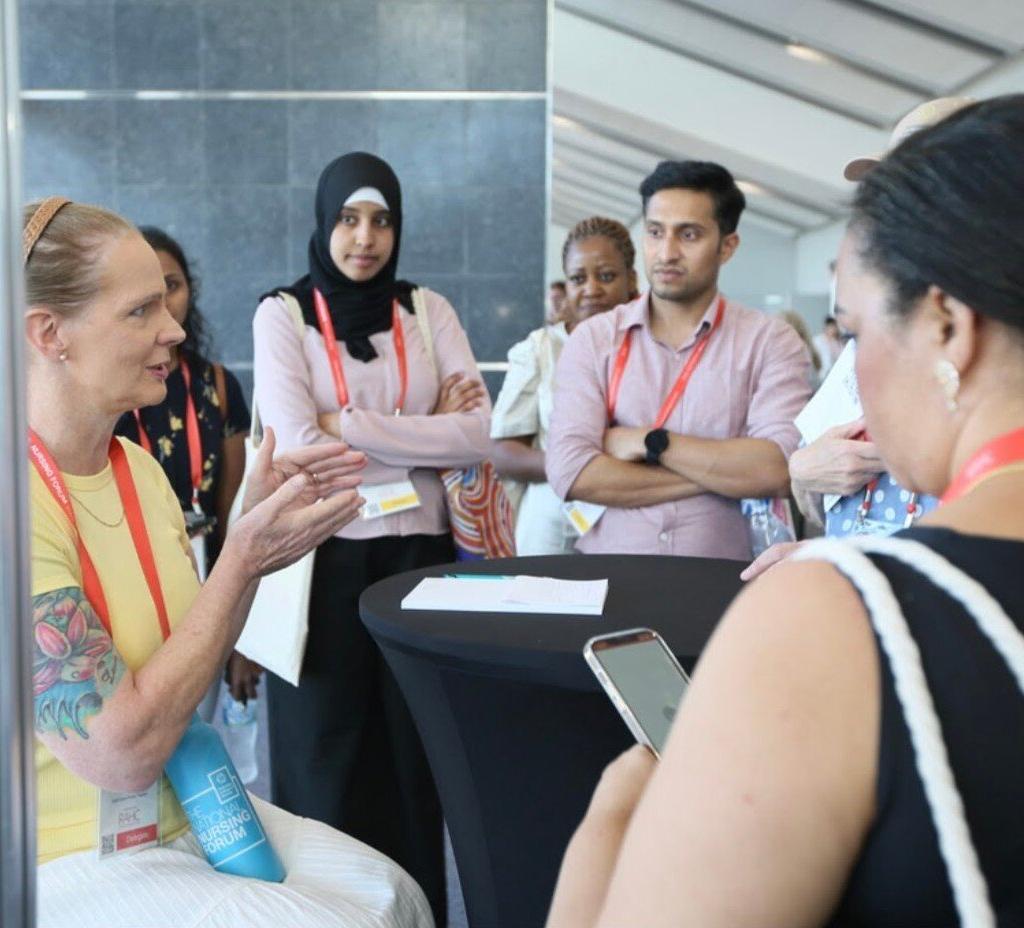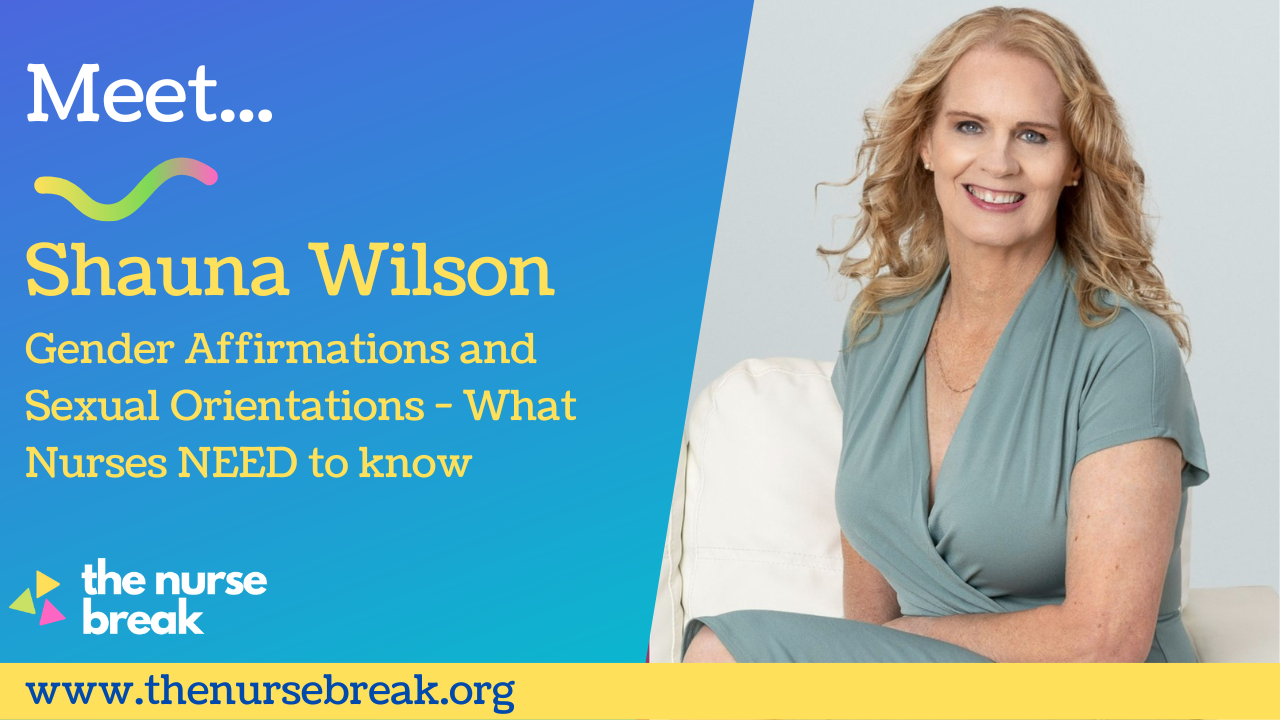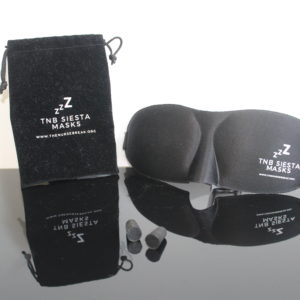Table of Contents
About
Shauna is a transwoman and nurse, who shares with us practical and thought-out advice, answering common questions about all things LGBTIQ+ and nursing! This is a MUST-READ for ALL students, healthcare professionals and clinical leaders.
Check out other must-read articles here
Shauna has a Diploma in Nursing from Kangan Batman TAFE and more than 8 years’ experience working within various healthcare fields including Geriatric, Community, Oncology, and currently as a civilian nurse contractor in the Defence environment. Shauna is the Co-chair of the ACN Diversity and Inclusion working party and the inaugural chair of the ACN Enrolled Nursing faculty advocating for enrolled nurses’ practice and education standards.

Can you tell us about your transition from the military/prisons to nursing?
Over my 42-year working life so far, the longest periods of employment have been as a prison officer and in the military as a serving member / public servant. It was during the latter as a full-time serving soldier that my mental health became affected by my gender dysphoria. This ultimately ended my serving career however, the very next day I commenced employment as a Defence civilian. It was during this time I went ahead with my gender affirmation to become whom I knew I truly was. This process involved extensive involvement with the healthcare sector and an even larger interaction with nurses.
I was approaching the young age of 50 when I sensed that I was no longer getting satisfaction out of my job. I wasn’t being fulfilled. I thought long and hard and recalled the caring and empathic nurses who cared for me during all my admissions.
I sat down with my partner (now husband) and discussed my leaving the lucrative public service role and commencing studying to be a nurse. To my delight, he told me to go for it which I was very excited to hear. This did scare me somewhat as this was the first time that I would have started a new career as the new me. I was insulated in my previous role as they knew me before my changes. As it turned out I worried for nothing as I was accepted as the old girl on the course.
What is it like being a transgender woman who is also a nurse?
Being a nurse who happens to be a transgendered woman has brought curiosity from some patients whom I have cared for. But mostly if there were any issues they are never raised. In all the environments I have practised there has always been acceptance. On occasion, there has been confusion in the use of incorrect pronouns, particularly among older male patients. I know this is due to my voice not being typically female in pitch all the time. I will correct someone if they repeatedly use the wrong pronoun but mostly, I will let it slide and carry on.
What does LGBTQIA+ mean? What does each letter refer to?
The acronym LGBTQ is the most common of all acronyms which have been around since the mid-1980s as a way to unite the community in which some found acceptance. Over the years since then, additional characters have been incorporated including I, A and +. For clarity and information, the acronym letters stand for:
Lesbian – refers to the affection and/or sexual attraction between consenting females.
Gay – refers to the affection and/or sexual attraction between consenting males.
Bisexual – refers to the affection and/or being sexually attracted to both men and women
Transgender – is an umbrella term used to refer to people whose gender they identify as is in conflict with the gender they were assigned at birth.
Queer – was once a term that was used in a derogatory way to identify someone who was not seen as “normal”. I still struggle with that word.
Intersex – is another umbrella term that refers to an individual who is born with anatomical, chromosomal and hormonal characteristics that do not align with those that conventionally define your gender as male or female.
Asexual – – a sexual orientation that reflects little to no sexual attraction, either within or outside relationships. People who identify as asexual can still experience romantic attraction across the sexuality continuum. While asexual people do not experience sexual attraction, this does not necessarily imply a lack of libido or sex drive.
+ – the symbol is an inclusive way to represent gender and sexual identities that cannot be described within the existing LGBTQIA acronym.
For those unaware, what is the difference between transwomen and transmen?
A trans man is an individual who was assigned the female gender at birth and has gone through gender affirmation to identify and answer as male. A trans woman is an individual who was assigned the male gender at birth and has gone through gender affirmation to identify and answer as female.
In both the above scenarios this can be either with or without surgical intervention. Do not assume someone who is trans has had surgery to alter their reproductive organs.
What key terms/words/phrases are NOT OK in 2023 to be using when talking about trans individuals?
Firstly, I would say do not overcomplicate what you want to say. I would steer away from the terms Biological or Genetics when trying to assess someone’s gender. I recently completed a registration form for a local GP clinic and one of the questions immediately after Gender was what gender I was assigned at birth. Harmless, and a question no one should find confronting.
Another term that I feel is outdated is the word homosexual. I would suggest using the terms gay or lesbian to describe people who are same gender attracted.
A definite no for me is the use of the term sex change. As I stated earlier, surgery is not always considered to fulfil the gender someone identifies as. When I am discussing my own experience, I use the term affirmation. I didn’t consider I was changing my sex, as the one I was assigned at birth was wrong. In my mind, I was always female. I have now affirmed that so everyone else knows it now.
Asking someone what is their sexual preference is assuming they had a choice in their selection. It is more appropriate to use the term sexual orientation.
Finally, these last three are just outright rude and insulting. Never use the terms tranny, She male or he/she.
Sexual orientation and gender identity – what is the difference?
This is a question that gets asked a lot and one that is easy to explain. For me, I try to keep it simple. Gender is internal and sexuality is external. Gender identity is internally whom I see myself as, and in what role in society I feel more comfortable and function better both physically and emotionally.
Sexual orientation refers to whom I am sexually and romantically attracted to. There is as much fluidity and confusion in this for everyone, not just in the transgender community. In my early years, I was sexually attracted to women. Since affirming my gender in 2008 my attraction is to males. I have been with the same man for coming on 13 years and married for 7.
Common misconceptions about transgender men and women you want to bust?
Firstly, I would like to add it is not a choice. Quite often I am asked, “So, when did you decide you wanted to be a woman”? For some, including myself, the only choice you are making is to live or die. Some may see this as dramatic, however, when you are filled with so much conflict both internally and externally it can be crippling.
Not everyone that identifies as transgender has found themselves there as a result of trauma or abuse.
Transgender is not a mental illness…. Period. Yes, it does require specialists in the mental health field to help you work through your situation but this is no different to any other reason a person seeks help from this field.
The old nature or nurture argument. How I was raised had no bearing on who I am today. I came from a loving caring family. Were there events in my early life that should never have happened, but did? Yes. But these events did not define how I got to where I am today.
Children who identify as trans at a very early age are not being forced to undergo irreversible procedures. The treatment and care of these children is given in small steps and over a very long period of time before anything irreversible is put on the table.
You cannot just turn up to the doctor and start treatment on a whim. It is difficult to access gender-affirming medical treatment in Australia. The process follows a set of guidelines that are governed by the World Professional Association for Transgender Health (WPATH) and involves multiple assessments with multidisciplinary teams with long wait times.
What is the way you would approach this clinical scenario?
“Your new emergency department patient identifies as transgender and they’ve already been called the wrong name multiple times by other clinicians and pronoun at triage. They’re scared and want to leave the hospital yet are unwell. What can we as nurses do to develop trust, create comfort, and keep our patients engaged in care?”
I had a discussion with a colleague this morning about her care staff assuming her partner was male. Comments like ‘your partner, he can bring you some things’ or ‘when can he pick you up? I had a recent admission to the hospital myself which required catheterisation. The ED nurse came in and asked me, in her words “Is it going to be a mess down there”.
As nursing staff, we must ensure we use respectful and culturally safe language in our care. Scenarios like these can prevent a member of the LGBTQIA+ community from presenting to hospitals or other healthcare settings. This interaction may be the first time they had built up the courage to open up. In saying that this language should be in your everyday practice. If a patient discloses to you that they’re from one of the LGBTQIA+ communities that is the first step in building a therapeutic relationship with your patient.
That can be hard to do sometimes. This patient has put their trust in you as a nurse to care for both their physical and emotional health. Before you start to care for your patient you should be looking at your unconscious bias and ask yourself how your own orientation or identity, attitude and beliefs affect your assumptions.
Being misgendered is common for someone who is transgender. When you are not focusing on the person and only listening to the voice you cannot always hear what you are seeing. In both my professional and personal life, I have been misgendered several times. It happens over the phone a lot. It hurts, it really does.
In one case my bank locked me out of my account even though I had answered all the security questions correctly. I know it is not intentional but it does have an effect on you at that moment. If you make that error then apologise and continue the conversation but also remind your team in an attempt to avoid reoccurrences.
Communicate in a way that is welcoming to your LGBTQIA+ patients. As I said earlier avoid assumptions and talk openly with them. Reassure them that any conversation had is private.
How can nursing leaders at the ANUM/NUM level promote LGBTQIA+ inclusivity and healthy work cultures?
Increase not just their own, but all their staff knowledge of LGBTQIA+ issues and needs. Advocate for LGBTQIA+ specific training and accreditation. Be proactive in promoting inclusive language.
Tell us about the role of recruitment bias and how it affects transgender people
HR departments need to actively promote a commitment to LGBTQIA+ inclusion through their recruitment advertising and processes. This will attract and reassure new and existing LGBTQIA+ applicants and employees that the employer has an inclusive environment. The organisation will become known as an employer of choice for LGBTQIA+ people.
If recruiters continue to hire staff in the like-for-like scenario, when challenges arise in the care of patients there is a risk of the same outcome coming from everyone involved. I know that when the medical staff at my first hospital had a post-presentation session with a transgender patient, I was able to enlighten them on what was probably going through the patient’s mind at the time. They were only focusing on her physical care and not looking any further into why she was reluctant to stop her hormone and alternative therapies.
Ultimately though HR cannot be seen as just ticking the Diversity and Inclusion box. It is extremely hard for someone who is transgender to have the confidence in putting themselves out there in the job market. It is even harder to know whether to apply pre-transition or post-transition. Particularly for the older applicants who may not present convincingly as they would hope in their gender identity.
I touched on it earlier that if the organisation is promoted as LGBTQIA+ friendly it can make the decision to apply easier and give the applicant more confidence in themselves. I elected to commence my transition 12 months after I commenced in my new role.
What are our undergraduate and TAFE nursing courses missing in regard to LGBTQIA+ training, broadly speaking?
For anyone that identifies as an LGBTQIA+ individual, their culture goes further than just race, age and ethnicity. Their cultures can be quite complex because they are coming to terms with finding a way to combine their culture of origin and their community with their LGBTQIA+ lifestyle. It is my belief that lived experience is far more beneficial in learning than what you will gain from a textbook.
I am a strong advocate for having a member of the LGBTQIA+ community present to students. Having one that is also a nurse is even more beneficial.
For anyone out there reading this who are struggling with their identity, what advice do you have?
Reach out. Use your network. Everyone has that one person in their life that they can confide in. If not, do some research on LGBTQIA+ community organisations for guidance. Stay strong, Stay positive. There are more peaks than there are troughs in your journey through life. And if all else fails contact me. I am more than happy to listen.
Are there any good further resources?
I would highly recommend ‘buying’ and reading ‘You say different, I say individual’. Very informative journey of a trans woman’s journey through life to find happiness and peace. A bit of shameless plugging of course… www.shaunawilson.com.au. Bonus: get free postage and a signed personal note inside to anyone that mentions this article
Another book I found amazing and bought copies for all family members and friends back in 2007. It is called ‘Trueselves’ and was written by Mildred L Brown and Chloe Ann Rounsley.
Here are some informative links to sites I accessed for some of the information I have provided above. Most information is from my lived experience but I am by no means the expert on all things trans.
- The World Professional Association for Transgender Health, 2012. Standards of Care for the Health of Transsexual, Transgender and Gender non-conforming people. 7th ed.s.l.: s.n.
- Australian Government Australian Institute of Family Studies Child Family Community Australia, LGBTQIA+ communities Glossary of common terms has a lot more terminology that is used in the LGBTQIA+ area. https://aifs.gov.au/cfca/publications/lgbtiq-communities
- ACN – Nursing Leadership in Diversity and Inclusion – Guiding Principles- https://www.acn.edu.au/wp-content/uploads/guiding-principles-nursing-leadership-in-diversity-and-inclusion.pdf
- https://www.rch.org.au/uploadedFiles/Main/Content/adolescent-medicine/australian-standards-of-care-and-treatment-guidelines-for-trans-and-gender-diverse-children-and-adolescents.pdf
- Trans Hub is an organisation that has its roots in NSW but its website is full of a lot of useful information for anyone that has questions. www.transhub.org.au






You must be logged in to post a comment.